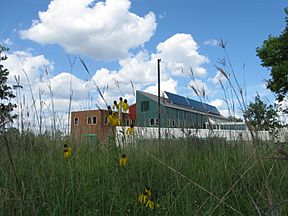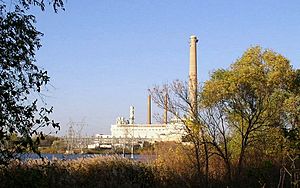Minnesota Valley National Wildlife Refuge facts for kids
Quick facts for kids Minnesota Valley National Wildlife Refuge |
|
|---|---|
|
IUCN Category IV (Habitat/Species Management Area)
|
|

Bloomington Education and Visitor Center
|
|
| Location | Dakota, Hennepin, Scott, Carver, Sibley, Le Sueur counties, Minnesota, USA |
| Nearest city | Bloomington, Minnesota |
| Area | 14,000 acres (5,666 ha) |
| Established | 1976 |
| Governing body | United States Fish and Wildlife Service |
| Website | Minnesota Valley National Wildlife RefugeMinnesota Valley National Wildlife Refuge Facebook Page |
The Minnesota Valley National Wildlife Refuge is a huge natural area in Minnesota. It covers about 14,000 acres, which is like 14,000 football fields! This special place is just south of Minneapolis, a big city in Minnesota. It's one of only fourteen "Urban Wildlife Refuges" in the whole country. This means it's a wild space right next to busy cities.
Many parts of the Refuge are close to famous places. The main visitor center is near the Mall of America. Another part is close to Valleyfair amusement park. Even the Minnesota Renaissance Festival is near one of its sections.
The Refuge stretches for about 70 miles along the Minnesota River. It's made up of eleven different sections, called "units." These units are mixed in with parts of the Minnesota Valley State Recreation Area. Even though different groups manage them, they use similar signs. This makes it easy for visitors to find their way around.
The Refuge has two main visitor centers where you can learn more:
- The Bloomington Education and Visitor Center is in Bloomington, MN. It's part of the Long Meadow Lake Unit. You can find hiking trails and cool exhibits here. It's usually open Tuesday through Sunday.
- The Rapids Lake Education and Visitor Center is in Carver, MN. It's part of the Rapids Lake Unit. This center also has hiking trails. Short walks can lead you to amazing views of the Minnesota River. It's usually open Tuesday through Friday, but it's a good idea to call ahead.
Even if the visitor centers are closed, the Refuge's trails are open every day from sunrise to sunset. You can visit them all year long!
Contents
Exploring the Refuge Units
The Minnesota Valley National Wildlife Refuge has 12 different sections, or units. They are spread out from east to west along the river.
Long Meadow Lake Unit
This unit is about 2,400 acres and is in Bloomington. It has lakes and ponds surrounded by wetlands. There are also forests that grow near the river.
You can find about 11 miles of trails here. These trails lead into the valley from the visitor center. You can walk or bike on them. There's even a special trail around the Bass Ponds. Long ago, from 1926 to the 1950s, people raised fish here to put into lakes all over the state.
A cool old bridge, the Cedar Avenue Bridge, was fixed up in 2016. It now has paths for bikes and walkers. You can cross it to get to Fort Snelling State Park. There's also a new boardwalk with a big platform for watching wildlife. They even plan to add telescopes there!
Black Dog Preserve
This unit is about 1,400 acres and surrounds Black Dog Lake in Burnsville. The lake is named after Chief Black Dog. He was a leader of the Mdewakanton Sioux people. His group had a village here around 1750.
This area protects special kinds of land like prairie and fens. You'll see the Xcel Energy’s Black Dog Power Plant in the middle of this unit. Clean water from the plant goes into Black Dog Lake to cool down. Because of this, some water birds stay on the lake longer in the winter.
There's a two-mile trail through the wetlands south of the lake. You can park at either end of the trail. There's also a viewing platform on the north side of the lake.
Bloomington Ferry Unit
This unit is about 400 acres in southwest Bloomington. It has marshes and floodplain forests. A big wetland called Opus Marsh is in this area.
You can find a one-mile trail along the riverbank here. There's also a bridge that connects to the Refuge's Wilkie Unit.
Wilkie Unit
This unit is about 2,100 acres in Savage and Shakopee. It has three main lakes: Blue, Rice, and Fisher. There are also large marsh areas and forests.
You can find five miles of trails here for hiking and cross-country skiing. This unit is home to the largest great blue heron rookery (a place where birds nest) in Minnesota. It has over 600 nests! To protect the birds, part of this unit is closed from March to August.
Chaska Unit
This 600-acre unit was added in 2001. It's located between the towns of Chaska and Carver. It has a lake, marsh, old fields, and river bottom forests.
A two-mile trail runs through these different habitats. It's a great place to see water birds and other wading birds in spring, late summer, and fall. You can park at the Chaska Ballpark or Riverside Park in Carver.
Louisville Swamp Unit
This 2,600-acre unit is famous for its large marsh called Louisville Swamp. This swamp often floods, so trails might be closed. A special structure helps control the water flowing into the Minnesota River.
This unit also has higher lands with old fields, prairie, and oak savanna. It's located near Jordan, Minnesota.
Long ago, a Wahpeton Sioux village called Inyan Ceyaka Otonwe was here. The unit's Mazomani Trail is named after a Wahpeton chief. A fur trading post was also built nearby in 1802. You can still see the remains of two old farms here. At the Jabs Farm, two buildings have been fixed up. The barn was built in 1880.
There are thirteen miles of trails for hiking and cross-country skiing. The parking lot for this unit is near the Minnesota Renaissance Festival. Be aware that traffic can be very busy during the festival!
Rapids Lake and San Francisco Units
This unit is about 1,888 acres. It's across the river from the Louisville Swamp Unit. Old fields here have been turned back into prairie and oak savanna. There's also a wetland that was restored in 1992. Believe it or not, part of this unit used to be a turkey farm!
The U.S. Fish & Wildlife Service built the Rapids Lake Education and Visitor Center here. It has the visitor center, an outdoor education area, and even a place for interns to stay.
There are three miles of trails in this unit. You can get to them from County Road 45. Two small areas in this unit are called the San Francisco Unit.
St. Lawrence, Jessenland and Blakeley Units
These three units are newer parts of the Refuge. The St. Lawrence Unit is 303 acres. The Jessenland Unit is 1,827 acres. The Blakeley Unit is 136 acres.
History of the Refuge
Plans to create a wildlife refuge along the Minnesota River started a long time ago. But World War II put those plans on hold. In the early 1970s, people realized the area needed to be protected from development. So, in 1976, a law was passed to create the National Wildlife Refuge.
The Old Cedar Avenue Bridge, built in 1920, crosses Long Meadow Lake. It was closed to cars in 1993 and then completely closed in 2002 because it was in bad shape. People really wanted to fix or replace it. Work began in 2015 and was finished in 2016, making it safe for walkers and bikers again.
In the late 1990s, the Minneapolis–Saint Paul International Airport planned a new runway. This runway would send planes over parts of the refuge. To make up for the extra noise, the airport paid $26 million into the Minnesota Valley Trust. Some of this money was used in 2004 and 2005 to buy more land for the refuge.




